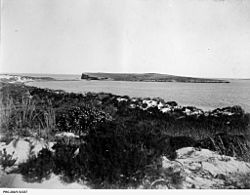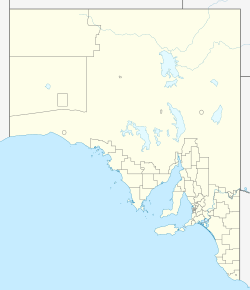South Island (South Australia) facts for kids

South Island as viewed from the nearby coastline circa 1912
(State Library of South Australia PRG 280/1/3/237) |
|
| Geography | |
|---|---|
| Location | Spencer Gulf |
| Coordinates | 35°14′S 136°50′E / 35.23°S 136.83°E |
| Highest elevation | 18 m (59 ft) |
| Administration | |
South Island is a cool island in South Australia, also known by names like Peter Island or West Bay Island. It's found at the southern end of Pondalowie Bay, which is on the south-west tip of the Yorke Peninsula. The island is about 11 kilometers (7 miles) north-west of the town of Stenhouse Bay.
South Island has been a special protected area since 1970. Since 1977, it has been part of the Innes National Park. This means the island's plants and animals are kept safe.
Contents
What South Island Looks Like
South Island is located off the south-west coast of the Yorke Peninsula. It sits at the southern end of Pondalowie Bay.
The island has very steep cliffs on its north and west sides. These parts face the open ocean. The highest point on the island is about 18 meters (59 feet) above sea level. The east and south sides of the island are more sheltered. Here, you'll find lower cliffs and rocky ledges. These are shaped by the ocean waves that curve into the bay.
South Island is connected to the mainland by a narrow strip of rock and sand. This strip becomes dry at low tide. This means animals can sometimes walk between the island and the mainland.
How South Island Formed
South Island was created around 6,000 years ago. This happened when sea levels rose after the last ice age. The island is made of a type of rock called calcarenite. This rock sits on top of a base of granite.
South Island is actually the part of a hidden reef system that always stays above water. This reef system stretches out from the southern headland of Pondalowie Bay.
Plants and Animals
Amazing Plants on South Island
In 1982, scientists studied the plants on South Island. They found that the plants grew in two main groups. These groups depended on how much wind and sea spray they got, and how much soil was available.
The western side of the island has a "low, open heath" area. The plants here grow in any small hollows or cracks filled with soil. These plants are tough and can handle salty, rocky coastal conditions. Some examples include round-leaved pigface, creeping brookweed, marsh saltbush, southern sea heath, and bassia.
The eastern side of the island is more protected from the weather. It also has more soil than the western side. This area supports a heath with about 40 different plant species. Some of these plants are bower spinach, coast beard-heath, coast daisy-bush, coast velvet-bush, cockies tongue, and common correa. You can also find dryland teatree, feather spear-grass, and native juniper here.
Cool Animals on South Island
Scientists have also looked at the animals living on South Island. They found mammals and birds. In 1982, they saw signs that kangaroos had visited the island. This likely happened at low tide when the rocky path to the mainland was dry.
Several bird species were also seen in 1982. These included the osprey, Pacific gull, silver gull, and welcome swallow.
Island History
Early Human History
Because South Island can be reached by foot at low tide, it's thought that Aboriginal people might have used it a long time ago. They may have used the island to trap kangaroos for food.
Later History
Over time, the island has been called different names. These include Peter Island, South Island, South Islet, and West Bay Island.
There is a special light on the island's north-west coast. This light helps ships navigate safely. It's an automatic light run by the Australian Maritime Safety Authority.
Why South Island is Protected
South Island became a protected area on November 26, 1970. This was done to protect its animals. Later, on June 2, 1977, it became part of the Innes National Park.
The waters around South Island are also protected. Since 2012, they have been part of a special "habitat protection zone" within the South Spencer Gulf Marine Park. This helps keep the ocean environment safe for marine life.
Since at least 2014, visitors are not allowed to go onto South Island. The same rule applies to the other two islands in Pondalowie Bay: Royston Island and Middle Island. This helps protect the sensitive island ecosystems.


